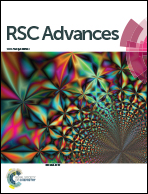Flexible and high energy density solid-state asymmetric supercapacitor based on polythiophene nanocomposites and charcoal†
Abstract
An asymmetric supercapacitor (ASC) was constructed using a polythiophene/aluminium oxide (PTHA) nanocomposite as an anode electrode and charcoal as a cathode electrode. The highest specific capacitance (Csp) of the PTHA electrode was found to be 554.03 F g−1 at a current density (CD) of 1 A g−1 and that of the charcoal electrode was 374.71 F g−1 at 1.4 A g−1, measured using a three electrode system. The maximum Csp obtained for the assembled PTHA//charcoal asymmetric supercapacitor (ASC) was 265.14 F g−1 at 2 A g−1. It also showed a high energy density of 42.0 W h kg−1 at a power density of 735.86 W kg−1 and capacitance retention of 94.61% even after 2000 cycles. Moreover, it is worth mentioning that the asymmetric device was used to illuminate a light emitting diode (LED) for more than 15 minutes. This PTHA//charcoal ASC also possesses stable electrochemical properties in different bending positions and hence finds a promising application in flexible, wearable and portable energy storage electronic devices.



 Please wait while we load your content...
Please wait while we load your content...